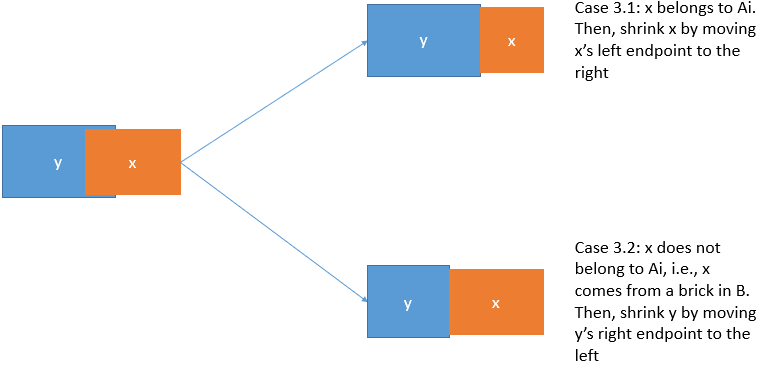Problem: Rectangle Shrinking
Part 1: Notations
$$$x$$$: A brick. $$$x_i$$$ denotes the part of $$$x$$$ belonging to the $$$i$$$-th floor. For example, if $$$x.u=1,\,x.d=2$$$, then $$$x_1.u=x_1.d=1$$$, $$$x_2.u=x_2.d=2$$$, and $$$x_1.l=x_2.l=x.l$$$, $$$x_1.r=x_2.r=x.r$$$.
$$$A_i,\,i=1,2$$$: The set of bricks whose $$$u=d=i$$$.
$$$B$$$: The set of bricks whose $$$u=1,\,d=2$$$.
$$$\texttt{Remove}$$$: Remove a brick $$$x$$$.
$$$\texttt{Shrink}$$$: Shrink a brick $$$x$$$ to another non-empty brick.
$$$\texttt{Keep}$$$: Keep a brick $$$x$$$ unchanged.
Note that in our solution we may operate on a part of brick. For example, for a brick $$$x \in B$$$, we may $$$\texttt{Keep}\,x_1$$$ while $$$\texttt{Remove}\,x_2$$$.
Part 2: Idea
I think $$$\texttt{Shrink}$$$ing $$$x \in B$$$ is troublesome. If you shrink $$$x_1$$$, you have to shrink $$$x_2$$$ in the same way, i.e., $$$x_1$$$ has to be aligned with $$$x_2$$$. So is there a solution that only performs $$$\texttt{Remove}$$$ and $$$\texttt{Keep}$$$ on every $$$x \in B$$$? But that is impossible, because the bricks $$$x, y \in B$$$ may overlap themselves even with considering $$$A$$$. So what if $$$B$$$ are pairwise non-overlapping (because we could perform some pre-$$$\texttt{Shrink}$$$ and pre-$$$\texttt{Remove}$$$ to make $$$B$$$ pairwise non-overlapping)? [Pre-computation]
In that case, we can consider each floor independently. Let
$$$C_i := A_i \cup \{x_i \mid x \in B \}$$$.
For example, if
$$$A_1 = \{[u=1, d=1, l=2, r=5], [u=1, d=1, l=7, r=10]\}$$$,
$$$B=\{[u=1, d=2, l=2, r=2], [u=1, d=2, l=4, r=7]\}$$$, then
$$$C_1 = \{[u=1, d=1, l=2, r=2], [u=1, d=1, l=2, r=5], [u=1, d=1, l=4, r=7], [u=1, d=1, l=7, r=10]\}$$$.
We sort $$$C_i$$$ w.r.t $$$l$$$, and traverse $$$C_i$$$ like $$$\texttt{for(auto x: C_i)}$$$.
Case 1 ($$$\texttt{Keep}$$$): If $$$x$$$ is not overlapping now, then we add $$$x$$$ to the answer, no matter if $$$x$$$ is from $$$A_i$$$ or not.
Case 2 ($$$\texttt{Remove}$$$): If $$$x$$$ is fully contained in the union of other rectangles, then we always remove $$$x$$$, no matter if $$$x$$$ is from $$$A_i$$$ or not.
$$$\texttt{Keep}$$$ and $$$\texttt{Remove}$$$ are relatively easier, no matter $$$x \in A_i$$$ or $$$x \in \{x_i \mid x \in B \}$$$.
Case 3 ($$$\texttt{Shrink}$$$): If $$$x$$$ is partially overlapping with other bricks.
Case 3.1: If $$$x \in A_i$$$: $$$\texttt{Shrink} x$$$. Move the $$$x.l$$$ to the right to avoid overlapping.
Case 3.2: If $$$x \in \{x_i \mid x \in B \}$$$: $$$\texttt{Shrink}$$$ all bricks that overlap with $$$x$$$ by moving their right endpoints (i.e., *.r), to the left.

It is guaranteed in Case 3.2 that every brick overlapping with $$$x$$$ is from $$$A_i$$$ because we have already performed pre-calculations in $$$B$$$ to make them non-overlapping. The complexity is not an issue, by amortized analysis, each $$$x \in A_i$$$ will do $$$\texttt{Remove}$$$ at most once and $$$\texttt{Remove}+\texttt{Shrink}$$$ at most twice (keep/move left endpoint+keep/move right endpoint).
Part 3: Implementation
First I copy a range-set implementation from nok0. Basically, it maintains a set of intervals using $$$\texttt{std::set}$$$. When inserting/erasing a range, it can merge/split/erase intervals automatically, using binary search (Yes, stop learning useless algorithms, go to learn binary search!). It supports many APIs, here are some useful APIs in our implementation:
(1) $$$\texttt{Insert(l, r)}$$$: Insert an interval $$$[l, r]$$$.
(2) $$$\texttt{covered_by(l, r)}$$$: Return an interval covering $$$[l, r]$$$, if not exists, returning $$$(-\infty, \infty)$$$.
(3) $$$\texttt{covered(l, r)}$$$: Return a bool variable indication whether interval $$$[l, r]$$$ is fully covered.
(4) $$$\texttt{right(x)}$$$: Return $$$\min \{y|y \geq x, y \text{ is not covered}\}$$$. Note that API could calculate the $$$\texttt{mex}$$$, so it is also useful for calculating the Sprague-Grundy (SG) number. SG number is irrelevant to our topic.
(5) $$$\texttt{left(x)}$$$ (added by me): Return $$$\max \{y|y \leq x, y \text{ is not covered}\}$$$.
There are also APIs that we don't use in this implementation, but they are also beneficial:
(6) $$$\texttt{Erase(l, r)}$$$: Erase $$$[l, r]$$$. That may lead to interval splitting, for example, if we erase $$$[2, 3]$$$ from $$$[1, 4]$$$, we get two intervals remaining: $$$[1, 1]$$$ and $$$[4, 4]$$$.
(7) $$$\texttt{size}$$$: Get the size of intervals.
(8) $$$\texttt{dump}$$$: Output all intervals for debugging.
So, we implement the pre-computation step (first paragraph in Part2) as follows:
sort B w.r.t l (left endpoint).
Initial a range set named rs.
for(auto& x: B){
int rightl = rs.right(x.l), leftr = rs.left(x.r);
if(right <= rightr){
rs.insert(rightl, leftr);
for(int i = 0; i <= 1; ++i) {
Ci = Ai; Ci.push_back({x.u, x.rightl, x.d, x.leftr, x.id}); //push into Ci
}
}else{
//Case 2, fully contained, remove it!
//We actually do nothing here
}
}
Then, how to calculate each floor independently? We need another set that is sorted by $$$r$$$, let's call it $$$\texttt{sortbyr}$$$. If Case 3.2 happens, we need to find such $$$y$$$ quickly by $$$sortbyr.lower_bound(x.l)$$$, i.e., find an interval $$$y \in A_i$$$ quickly, using binary search, such that the right endpoint of $$$y$$$ ($$$y.r$$$) is greater or equal than $$$x.l$$$.






